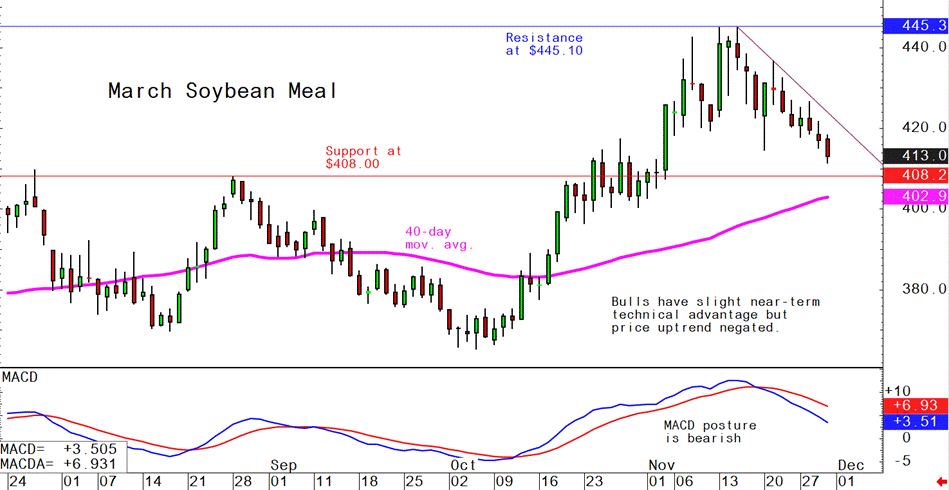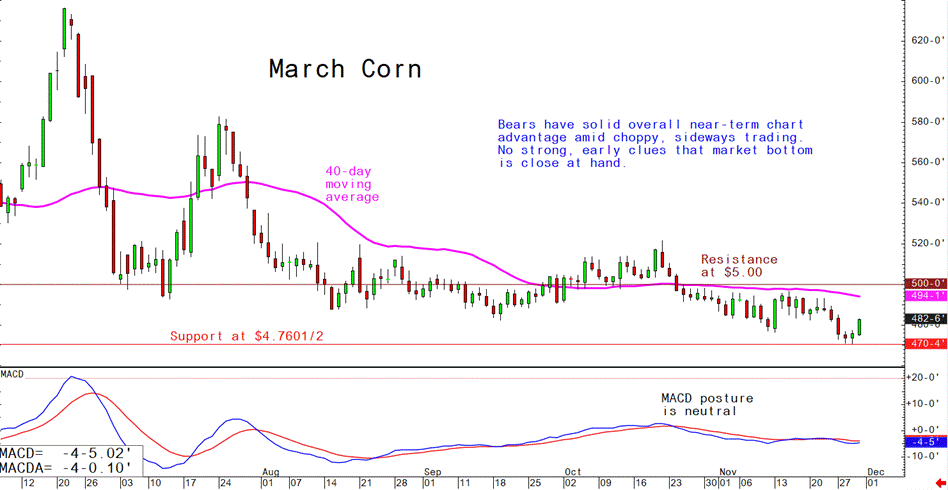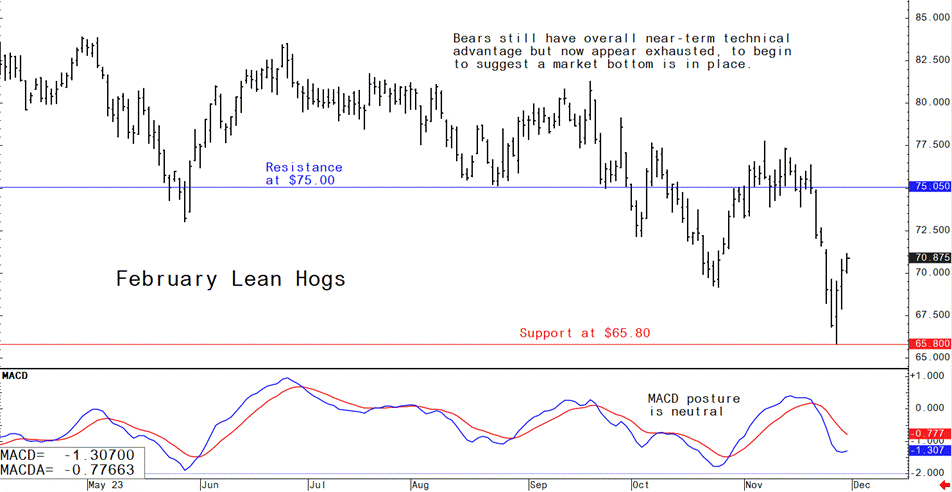



Pig outlook — Lean hog bears now appear exhausted, US line speeds, China's pig market
Livestock analyst Jim Wyckoff shares pig news from around the globeFebruary lean hog futures prices have made a solid rebound from this week’s spike down to a contract low. The rebound suggests the bears became exhausted, which also suggests a near-term market bottom is in place. Fundamentally, US hog slaughter weights are rising seasonally, running well above both year-ago and the five-year average. While a seasonal top in weights should come soon, there are no indications it will happen this week. The extra pork is likely to keep pressure on the cash hog market for the near term. The latest CME lean hog index is down 13 cents to $71.53 as of Nov. 28.
Weekly USDA export sales for US pork
US Pork: Net sales of 21,200 MT for 2023 were down 20 percent from the previous week and 35 percent from the prior 4-week average. Increases primarily for Mexico (7,500 MT, including decreases of 1,100 MT), South Korea (3,400 MT, including decreases of 300 MT), Japan (3,000 MT, including decreases of 300 MT), Australia (1,600 MT), and Colombia (1,600 MT, including decreases of 300 MT), were offset by reductions for China (100 MT). Net sales of 5,600 MT for 2024 were primarily for Japan (2,800 MT), Canada (1,100 MT), Mexico (300 MT), the Dominican Republic (300 MT), and South Korea (300 MT). Exports of 27,800 MT were down 14 percent from the previous week and 13 percent from the prior 4-week average. The destinations were primarily to Mexico (9,800 MT), South Korea (4,500 MT), Japan (4,200 MT), China (2,100 MT), and Canada (1,900 MT).
USDA extends NSIS trial for pork industry by 90 days
USDA has announced the Time-Limited Trial for New Swine Inspection System (NSIS) plants will be extended for an additional 90 days, providing certainty for our pork industry and ensuring participating plants can continue operating at increased line speeds.
Details: In March 2021, a court order issued by the U.S. District Court for the District of Minnesota vacated the component of USDA’s New Swine Slaughter Inspection System (NSIS) that eliminated line speed limits for participating establishments. As a result, all NSIS establishments were required to operate at line speeds not exceeding 1,106 head per hour as of June 30, 2021. In November 2021, USDA’s Food Safety and Inspection Service (FSIS), in consultation with the Occupational Safety and Health Administration, invited NSIS establishments to participate in a time-limited trial (TLT), during which the establishments have been allowed to operate at an increased line speed while collecting and submitting data that would be used to evaluate the impact of increased line speed on workers.
FSIS contracted with a third-party team of worker safety experts to evaluate the data submitted by the swine establishments. The team of experts determined that the data submitted was not sufficient to evaluate the impact of increased line speeds on worker safety in NSIS establishments. Accordingly, to obtain the data necessary to inform any future rulemaking, FSIS is commissioning a study that will independently generate the necessary data for expert analysis. FSIS as noted will extend the TLTs for up to an additional 90 days while the study is being designed by the team of experts.
FSIS will send letters to the six swine establishments with requirements they will need to continue to meet to operate a TLT during the 90-day period, including keeping in place measures outlined in their worker safety agreements. The agency will follow up with additional communication to the public once the details of the study, including its duration, are determined.
Congressional pressure. The announcement comes after Rep. Brad Finstad (R-Iowa) and Sen. Chuck Grassley (R-Iowa) led a bicameral group of 18 Members of Congress on November 2, 2023, in sending a letter to USDA Secretary Tom Vilsack, urging the agency to immediately issue an extension of the Time-Limited Trial for the six NSIS pork processing plants. House Ag Chair G.T. Thompson (R-Pa.), while welcoming the short-term extension, said he remained “concerned that the Biden administration’s actions on pork processing line speeds only removes the certainty that the nation’s producers, processors, and consumers deserve. As USDA moves toward a more permanent solution, it is my hope the department operates with transparency to ensure our pork processing facilities can maintain full operational capacity and protect our nation’s food supply."
The National Pork Producers Council (NPPC) applauded the announcement. “Amidst a historically dire pork market, we thank Secretary Vilsack for his actions to preserve harvest capacity, which provides market power to producers when selling hogs,” said NPPC President and Missouri pork producer Scott Hays. “Without the extension, pork producers would incur additional losses of nearly $10/head in Q1 and Q2 2024.”
China to buy more pork to support prices
China will buy another 10,000 MT tons of pork for state reserves on Wednesday, the country’s reserve management center said. This will be the third batch of pork purchases by the government to support falling hog prices.
Chinese hog futures plunge to record-low
China’s most active hog futures closed down 5.69% on Monday at a record low, after farmers ramped up selling of pigs following months of weak prices. Farmers accelerated herd liquidation in recent weeks, as cash hog prices dropped another 4% last week. January hog futures have plunged more than 9% so far this month.
China's swine fever epidemic leaves lasting global pork market impact
China, the world's top producer and consumer of pork, faced a significant outbreak of African swine fever among its pig herds that lasted for three years until late 2021. Despite its recovery, the domestic pork market in China remains volatile, posing potential uncertainties for pork exporters worldwide. The epidemic had lasting impacts on the global pork market, as outlined in a report by three USDA economists:
- Pork output impact: During the 30 months of the epidemic, China's pork production dropped by an average of 18% below normal levels.
- Consumer price surge: Pork prices for consumers doubled for 14 months, ending in January 2021, and only returned to pre-epidemic levels by September 2021.
- Limited imports: Although record amounts of pork were imported during the outbreak, they could only replace a fraction of the lost production.
- Hog farming consolidation: The epidemic led to the consolidation of hog farming into larger-scale operations.
- Higher production costs: China incurred higher production costs due to the construction of new, larger hog farms and stricter biosecurity practices.
- Sustained demand for imported pork: Rising pork prices in China, reflecting increased production costs, may continue to support the demand for imported pork, despite China's expansion of pork production capacity.
- Global pork market: China remained the world's largest pork importer in 2022, though its share of the global market was less than one-third of its peak during the epidemic.
- Bottom line: The recovery and ongoing dynamics in China's pork industry have implications for both domestic and international markets, highlighting the complexities of the global pork trade.
US pork stocks fall more than average; beef stocks rise more than normal
USDA’s Cold Storage Report showed 444.3 million lbs. of US beef in frozen storage at the end of October, up 23.5 million lbs. (5.6%) from September. The five-year average was a 12.2-million-lb. increase in beef stocks during the month. Beef inventories dropped 65.9 million lbs. (12.9%) from last year and were 48.8 million lbs. (9.9%) under the five-year average. US pork stocks stood at 435.9 million lbs., down 25.7 million lbs. (5.6%) from September. The five-year average was a 15.7-million-lb. decrease during the month. Pork inventories fell 73.8 million lbs. (14.5%) from year-ago and were 80.5 million lbs. (15.6%) below the five-year average.
The next week’s likely high-low price trading ranges:
February lean hog futures--$68.00 to $75.00 and with a sideways bias
March soybean meal futures--$400.00 to $430.00, and with a sideways-lower bias
March corn futures--$4.70 1/2 to $5.00 and a sideways-lower bias
Latest analytical daily charts lean hog, soybean meal and corn futures












